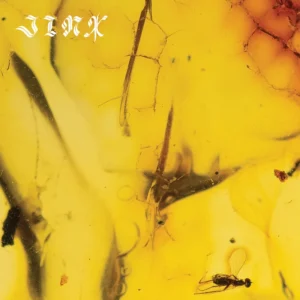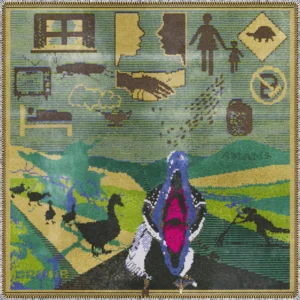In the ever-evolving landscape of modern indie music, few bands manage to carve out a niche as distinct and spellbinding as Crumb. With their ethereal blend of dream pop, jazz-inflected grooves, and psychedelic textures, this Brooklyn-based quartet has cultivated a soundscape that feels at once nostalgic and otherworldly. Crumb’s music is a kaleidoscope of colors, swirling with hypnotic melodies, intricate instrumentation, and an almost cinematic sense of atmosphere that draws listeners into a world all their own.
Background: The Roots of Crumb’s Psychedelic Journey
Early Life
Each member of Crumb brings a unique story to the band’s identity, though their collective roots trace back to their college days at Tufts University in Massachusetts. Frontwoman Lila Ramani, who grew up in New Jersey, discovered her passion for songwriting and music as a teenager. Her early experiences of blending poetry with guitar-based melodies laid the groundwork for the band’s introspective and textured approach to songwriting.
Meanwhile, keyboardist Brian Aronow and bassist Jesse Brotter, both hailing from creative households, had their own paths into music shaped by classical training and jazz improvisation, respectively. Drummer Jonathan Gilad, originally from Paris, France, was steeped in a diverse array of rhythmic traditions before moving to the U.S. and diving headfirst into the indie music scene. Together, these disparate backgrounds formed the eclectic, genre-fluid foundation that would become Crumb’s hallmark.
Musical Beginnings
Crumb officially came to life as a project in 2016, when Ramani asked her bandmates to help flesh out a collection of songs she had written during her time at Tufts. Their chemistry was undeniable, and the group soon transformed what was initially a casual collaboration into a fully realized band.
Their debut self-titled EP, released in 2016, showcased a knack for weaving groovy, jazz-inflected riffs with lush, dreamy vocals, immediately setting them apart in the indie music sphere. A follow-up EP, Locket (2017), solidified their status as rising stars, earning them a dedicated fan base and critical acclaim for their ability to craft immersive sonic landscapes that feel both intimate and expansive.
Artistic Influences
Crumb’s sound reflects a broad tapestry of influences, blending elements of jazz, psych rock, dream pop, and R&B into a cohesive and idiosyncratic style. The band cites artists like Jimi Hendrix, Radiohead, and The Beach Boys as early inspirations, particularly in their ability to experiment with form and texture. Jazz greats such as Miles Davis and John Coltrane also left their mark, particularly in the freeform, improvisational spirit that often animates Crumb’s live performances.
Equally important are contemporary indie and experimental acts like Broadcast and Tame Impala, whose balance of vintage psychedelia with modern production mirrors Crumb’s own ethos. Yet, for all their influences, Crumb’s sound remains uniquely theirs—an amalgamation of their individual sensibilities, with each member contributing distinct textures to the band’s sonic palette.
Discography Overview
1. Jinx (2019)

Crumb’s debut full-length album, Jinx, marked a bold evolution from their earlier EPs, offering a more cohesive and mature sonic identity. The album is a hypnotic exploration of mood and texture, balancing hazy, psychedelic undertones with tightly crafted grooves. Songs like “Nina” and “Ghostride” delve into themes of self-reflection, anxiety, and fleeting human connections, anchored by Lila Ramani’s ethereal vocals and Brian Aronow’s otherworldly keyboard textures.
A standout track, “Part III,” epitomizes the album’s hypnotic charm with its swirling guitars and jazz-inflected rhythms, encapsulating the band’s knack for blending the surreal with the deeply personal. Across its 10 tracks, Jinx feels like a lucid dream, shifting effortlessly between haunting minimalism and rich, kaleidoscopic arrangements. It solidified Crumb as a major force in the indie-psych scene and hinted at even greater experimentation to come.
2. Ice Melt (2021)

Ice Melt, Crumb’s sophomore album, pushes the band’s sonic experimentation even further, offering an immersive experience that feels more tactile and visceral than its predecessor. While retaining their signature psychedelic and jazzy core, Ice Melt introduces a rawer, more organic edge, inspired in part by the band’s experiences recording at a historic studio in Los Angeles.
The album’s themes of human connection, loss, and transformation are underscored by its title, which reflects both physical change and emotional thawing. Tracks like “BNR” and “Trophy” showcase the band’s growing affinity for groove-driven, almost hypnotic arrangements, while “Balloon” highlights a playful yet introspective side, carried by intricate percussion and a labyrinth of vocal harmonies.
One of the most striking tracks, “Up & Down,” captures the album’s dichotomy between ethereal beauty and grounded, earthy textures. It’s a testament to the band’s ability to evolve while staying true to the essence of their sound: an exploration of the spaces between the tangible and the abstract.
3. Amama (2024)

Crumb’s third studio album, “AMAMA,” is a testament to the band’s artistic evolution and their ability to create captivating and immersive musical experiences. Building upon the foundations laid by their previous EPs, “AMAMA” delves deeper into the realms of psychedelic soundscapes, introspective lyricism, and intricate musical textures.
The album opens with the title track, “AMAMA,” setting the tone with its ethereal melodies and haunting vocals. Lila Ramani’s voice, delicate yet powerful, weaves through the layers of synths, guitars, and drums, creating a mesmerizing atmosphere. The song’s lyrics explore themes of self-discovery and acceptance, reflecting the band’s own journey of growth and transformation.
“Nina,” another standout track, showcases Crumb’s ability to craft emotionally charged songs with a subtle yet profound impact. The song’s melancholic melodies and introspective lyrics delve into themes of anxiety, loneliness, and the fleeting nature of human connections. Ramani’s vocals, imbued with vulnerability and raw emotion, resonate deeply with listeners, conveying a sense of universal human experience.
Industry Perspective: Crumb’s Path Through the Indie Maze
Challenges and Triumphs
Operating in the fiercely competitive and often unpredictable world of indie music, Crumb has faced its share of challenges. As a self-funded, independent band in their early days, they had to juggle the logistical and financial hurdles of recording, touring, and promoting their music without the backing of a major label. Despite these obstacles, their DIY ethos became a defining strength, allowing them to maintain creative control and build an organic, loyal fan base.
Another hurdle has been the delicate balance between creative exploration and audience expectations. Known for their distinctive sound, the band continually pushes boundaries, but this comes with the challenge of staying authentic while evolving. With each release, however, Crumb has proven their ability to surprise and captivate listeners without losing their core identity, a triumph of artistic integrity.
The COVID-19 pandemic also presented a major disruption, particularly during the release cycle of their sophomore album, Ice Melt. With live shows and tours put on hold, the band adapted by focusing on digital content and virtual engagement, maintaining their connection with fans during uncertain times.
Collaborations and Connections
Crumb’s collaborative spirit extends beyond their four members, as the band frequently taps into a broader creative network to enrich their music. They’ve worked with engineers and producers like Jonathan Rado of Foxygen, whose ability to capture analog warmth and experimental nuance aligns perfectly with Crumb’s aesthetic.
Their live performances often highlight their connection to the vibrant indie and experimental scenes, sharing stages with acts like Mild High Club and Men I Trust. These shared experiences with like-minded artists have not only elevated Crumb’s profile but also reinforced their place within a supportive community of musicians.
Beyond formal collaborations, the band’s close-knit dynamic allows for seamless creative exchange within the group itself. Each member brings unique ideas to the table, whether it’s Lila Ramani’s poetic songwriting, Brian Aronow’s multi-instrumental inventiveness, Jesse Brotter’s melodic basslines, or Jonathan Gilad’s jazz-informed drumming. Together, they create a sound that feels deeply interconnected and greater than the sum of its parts.
Recognition and Achievements
Crumb’s ascent in the indie music scene has been marked by a series of impressive milestones. Their debut EPs, Crumb (2016) and Locket (2017), quickly garnered attention, amassing millions of streams and earning glowing reviews for their originality and artistry. This early success set the stage for their first full-length album, Jinx (2019), which was met with critical acclaim and solidified their reputation as a unique voice in modern psychedelia.
Jinx earned the band a spot on year-end “best of” lists from outlets like Pitchfork and Consequence of Sound, while their sophomore album, Ice Melt (2021), showcased their staying power. The band has also cultivated a reputation for mesmerizing live shows, performing at iconic venues like Webster Hall and appearing at festivals such as Desert Daze and Primavera Sound, further cementing their status as a must-see act.
Impact and Legacy: Crumb’s Place in the Indie Psychedelic Canon
Cultural Significance
Crumb has emerged as a vital force in the indie music scene, redefining what it means to be a psychedelic artist in the modern era. While their music draws from the rich tradition of 60s and 70s psych rock, they’ve infused the genre with elements of jazz, R&B, and dream pop, creating a sound that feels uniquely contemporary. This blend of the familiar and the avant-garde has made Crumb a standout act, inspiring a wave of young artists to explore similarly genre-defying approaches.
Their impact extends beyond their genre. As an independent band, Crumb exemplifies the power of DIY artistry, showing how creativity, authenticity, and perseverance can thrive without the constraints of major-label systems. Their success is a testament to the shifting dynamics of the music industry, where streaming, social media, and grassroots touring enable artists to cultivate devoted audiences on their own terms.
Fanbase and Community
Crumb’s music has resonated deeply with listeners, fostering a tight-knit and passionate fanbase. Their fans, often drawn by the band’s introspective lyrics and immersive soundscapes, are as much participants in Crumb’s musical world as they are spectators. This sense of community is amplified during live performances, where the band’s dynamic interplay and hypnotic energy create a shared, almost transcendental experience.
Beyond their music, Crumb has cultivated a sense of intimacy and connection through their engagement with fans. Whether through cryptic visual teasers, playful social media interactions, or their commitment to smaller, intimate venues, the band exudes an aura of accessibility and relatability. Fans don’t just listen to Crumb—they feel part of an evolving creative journey.
Looking Forward
As Crumb continues to experiment and evolve, the possibilities for their future are as open-ended as their music. Their first two albums, Jinx and Ice Melt, have established them as trailblazers in the indie-psych genre, and their willingness to push sonic boundaries suggests that even more groundbreaking work lies ahead.
Their trajectory hints at a legacy of innovation and influence, particularly within the indie and experimental music communities. If they continue to grow their sound while maintaining their authenticity, Crumb has the potential to become one of the defining acts of their generation, inspiring countless artists to embrace their own unconventional visions.
As the band looks toward the next chapter, they seem poised to expand their reach while staying true to the ethos that made them resonate so deeply in the first place: creating music that blurs boundaries, evokes emotion, and invites listeners into a world all their own.
